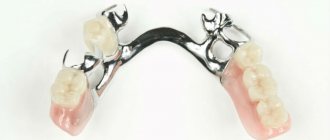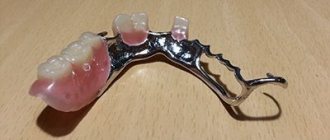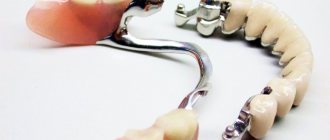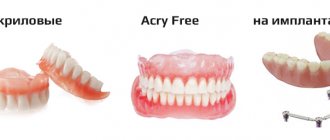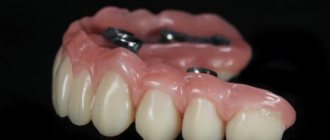Clasp prosthetics is a popular method of restoring the dentition, which uses removable dentures with clasps (hooks) and attachments (locks).
Designs with clasps are at least half the price, but they are durable, strong and reliable, and do not require special care. They are also considered a budget alternative to implants and a reliable analogue of bridges and plate prostheses.
What is a clasp prosthesis?
Clasp dental prosthetics is a widely used treatment method in orthopedic dentistry. Designed to restore teeth in both the lower and upper jaws. The name itself comes from the German “bugel”, which means “arc”, that is, bugel - literally “having an arc”. The design of clasp dentures includes a metal or plastic arch, artificial teeth that are attached to a base that imitates gums, and fixing elements in the form of hooks, clasps or crowns.
Removable clasp prosthesis for the lower jaw - consider in detail
Why is a denture for teeth called clasp? The name itself comes from the word “arc”. It is based on a thin cast arc-shaped metal element, onto which a plastic base imitating gum is fixed, as well as artificial crowns - smooth and beautiful teeth. Thanks to the arch, the teeth replacement system is highly durable and reliable, because it will have to be removed and put on at least once a day. As a result, the patient receives a compact, lightweight, comfortable prosthesis for the lower jaw, which is easy to get used to in the first few hours after installation.
How is the prosthesis fixed on the supporting, pre-prepared teeth of the lower jaw? Using hooks or special elements. They are placed on top of the patient’s teeth or on pre-implanted implants. By the way, the prosthesis locks themselves are made not only of a metal alloy, but also of plastic, which is especially important for people with an allergic reaction to metal. But the gums can be made of either nylon or plastic bases (acri-free, quadrotti solutions). When it comes to dental crowns, they are usually made from a plastic material that imitates enamel.
It is important! The specificity of the prosthesis for the lower jaw presupposes that the arch is located on the side of the tongue, that is, where it is not visualized at all. The distance from the arch to the cervical area of the teeth is approximately one millimeter, and a little more is the distance to the bottom of the mouth.
Stages of making a clasp prosthesis
Based on the principle of making the frame, the clasp prosthesis is divided into several types: soldered, solid-cast, milled, and based on laser sintering of nanoparticles of a special metal alloy powder. The last two methods are considered the most progressive and allow you to create a high-precision (up to 10 microns) and comfortable design.
Manufacturing takes place in 4 stages:
- first the dental technician creates a plaster model
- Based on the plaster model, a prototype of the prosthesis is cast and scanned
- using the scan, the frame of the clasp structure is modeled on a computer
- the prosthesis is ultimately sintered or milled.
The result exceeds all expectations - the prosthesis fits tightly to the gums and teeth, does not break and looks very aesthetically pleasing.
Classification
In dentistry, it is customary to use various criteria to differentiate clasps. So, from the point of view of the materials used for manufacturing, there are:
- Metal models (nickel, chrome-cobalt, precious metals);
- Polymer products;
- Combined options.
Based on the creation method, a distinction is made between stamped and bent-cast structures. At the same time, clasps are also divided into retaining and support-retaining, and from the point of view of shape they are divided into strip, round and semicircular. The connection of the retainer to the base is carried out using a rigid, springy or joint method.
Indications for clasp prosthetics
The main indication for clasp dentures is the inability to install dentures on implants and the presence of at least several supporting teeth to which it could be secured. Partial structures are most often used both to replace several teeth with terminal defects and to restore a single tooth.
Whereas the clasp upper and lower denture completely reproduces the entire dentition. In addition, there is a splinting clasp prosthesis, which is used as a structure that restores and supports teeth. The prosthesis splints teeth affected by periodontitis or periodontal disease from the inside, replaces missing parts of the dentition and prevents the occurrence of adentia and prolongs the performance of the affected teeth.
Contraindications include:
- oral diseases in the acute stage
- increased tooth wear
- diseases leading to bone loss
- low or missing abutment teeth
- deep bite
- chronic neurological and mental diseases
- short frenulum of the tongue
- shallow floor of the mouth
- allergy to metal or other materials used in the design
Types of clasp dentures
Clasp dentures are also divided according to the method of their attachment to the supporting teeth. Unlike completely removable structures, which are fixed by suction to the gum or using special adhesives, fixation and installation of clasp dentures occurs using several types of fastening.
On clasps
Clasp dentures with clasps consist of metal hooks that clasp the abutment tooth in the neck area. The clasp clasp prosthesis is attached without grinding down the enamel, provided that the supporting teeth are not destroyed or affected by severe caries. However, this type is not aesthetic enough - the hooks are noticeable when you smile.
On locks or attachments
A locking clasp prosthesis consists of two parts, one of which is attached to the ground abutment teeth, and the second with the help of locks to the prosthesis itself. Unlike other types, a clasp denture with attachments is more immobile, so the load is distributed evenly on the supporting teeth and the alveolar mucosa.
Clasp prosthesis on telescopic crowns
When installing a clasp prosthesis on telescopic crowns, first fixed metal crowns are placed on the supporting teeth, and then ceramic crowns are placed in the prosthesis.
Components of the clasp
The simplest holding clasp consists of 3 parts - the shoulder, the body, and the appendage.
A more complex version, the support-retaining one, consists of a shoulder, an occlusal pad, a body and a process. This composition is typical for the classic type of support-retaining clasp called Akker.
The arm of the clasp is the part that holds it on the tooth.
The body of the clasp connects all the elements together.
The process or connecting rod is an element that coppers the prosthesis and the clasp itself. And the size of the process depends on the type of prosthetics.
And the foot or occlusal pad is a kind of transmitter of chewing force on the tooth at the level of occlusion.
Nylon clasp quadrotti prosthesis
A product of the Italian company Quattro Ti, the quadrotti clasp prosthesis is very similar to a removable nylon prosthesis, with the only difference being that during its manufacture, nylon is mixed with hypoallergenic plastic. The resulting material has a number of advantages: it is more durable than nylon, and artificial teeth do not show through it. According to the manufacturers, this type of metal-free clasp prosthesis does not deform over time, does not cause discomfort when worn, and looks much more aesthetically pleasing than other prostheses. A soft prosthesis is attached to the teeth using plastic clasps, or saddles, covered on top with the same material as the base of the prosthesis. Saddles can be either pink or white, making them unnoticeable on the teeth. As for the disadvantages of the prosthesis, firstly, Quattro Ti is not strong enough, since no matter how strong the plastic is, it cannot be compared with metal. Secondly, a clasp prosthesis with nylon saddles requires special care using special means, which requires additional costs and cannot be repaired.
Caring for clasp dentures
Getting used to the clasp denture may take a couple of days. At first it will be somewhat uncomfortable for you to talk, so you will have to get rid of speech defects with the help of special exercises. Eating will also cause some difficulties. At first, to minimize pain, it is best to divide food into small portions and exclude very hard foods and sticky sweets from the diet. In order to quickly get used to the prosthesis, do not take it off at night.
Twice a day (morning, evening) it is necessary to remove the clasp prosthesis and clean it of plaque using the means recommended by the doctor, and also rinse it in a special antibacterial solution.
The clasp denture should be stored in a container, but not in water. Some types of structures, for example, soft quadrotti dentures, require special care, otherwise they fade and look unsightly on the teeth.
Service life and how to care
The average service life of a clasp clasp prosthesis is from five to seven years, which is very good for removable devices. This is due, firstly, to the high strength characteristics of the structure. And secondly, soft tissues under the clasp atrophy much more slowly than under plastic analogues, so its replacement will not be required soon.
Caring for a clasp prosthesis with clasp fixation is not particularly difficult. After each meal, it should be rinsed with water, and thoroughly cleaned in the morning and evening with a brush and special pastes. It is recommended to soak the prosthesis periodically (about once a week) in an antibacterial solution.
Advantages and disadvantages
For comparison, let’s take the clasp’s “classmates” - fixed bridges and removable plate prostheses. Clasp orthopedic structures, of course, are superior to plate ones in strength, but, like bridges, they are a temporary way to restore the dentition. Despite all the efforts of manufacturers, the clasp is not able to stop the loss of bone tissue, the inevitable decrease of which soon leads to changes in facial features and disturbances in the functioning of the dental system and internal organs. The obvious disadvantages of a removable clasp also include an aesthetic defect when installing a clasp prosthesis, when metal hooks attached to the teeth are visible, and a slow adaptation time to the design. In addition, any denture puts pressure on the gums and causes discomfort when chewing and hypoxia - a condition in which the gums do not have enough nutrition, which causes bone tissue to atrophy even faster. As for the service life of clasp dentures, compared to dental implants, it is quite short and is no more than 10 years. Subject to proper care and timely correction once a year.
Prosthetics for complete absence of teeth and for one tooth
In case of complete absence of teeth, clasp dentures are installed in one case - when supported by implants. This is a more advanced prosthetics principle from a functional point of view. It allows you to avoid resorption of the jaw bone tissue, evenly distributing the load on the bone.
Clasp prosthetics for one tooth before the advent of thermopolymer products were considered illogical, since they required grinding down adjacent and often completely healthy crowns. Metal-based dentures made it possible to replace a lost tooth only as part of complex structures - with lateral end defects and included defects of the anterior teeth.
Thanks to Quadrotti technology, there is currently no need to prepare adjacent healthy teeth for a prosthesis. And a single included defect in the dentition is successfully replaced with an elastic thermopolymer “butterfly”.
How much does partial denture cost?
The average cost of clasp dentures in Moscow consists of the cost of the material, the work of the dental technician and the method of attachment to the supporting teeth. So, despite their popularity, the cost of nylon quadrotti dentures for one jaw is approximately the same as the price of clasp dentures - from 45,000 rubles and more. Clasp dentures with locks are somewhat more expensive - from 35,000 to 80,000 rubles. The most expensive of removable structures are considered to be dentures with telescopic crowns - their price ranges from 100,000 rubles to 200,000 rubles and more. As for clasp dentures on implants, their cost starts from 90,000 to 200,000 rubles and more, depending on the number of implants installed. If you decide to have a clasp prosthesis installed, then choose trusted clinics here.
High-quality clasp prosthetics is a worthy alternative to implantation, and in times of economic depression, clasp prosthetics is the most optimal option for restoring missing teeth.
Advantages of clasp structures
So, patients and orthodontists note the following advantages when using clasp structures:
- Comfortable: The thin metal base arch allows the palate to be open. This ensures that patients can continue to enjoy food and live in style.
- The use of a metal arch does not interfere with diction and prevents unpleasant moments associated with the sudden loss of the prosthesis.
- Strength: the strength of the arch allows you to protect the prosthesis from breakage.
- Duration of service: up to 5 years of wearing the structure, which is considered a record period for removable dentures (for plastic types, the wearing period usually does not exceed 2-2.5 years).
- Slowing down the atrophic processes in the gums and jaws, which preserves the possibility of wearing the plates for the longest possible time.
- There is no need for daily removal at night.
- Rare cases of stomatitis.
- A splinting prosthesis on clasps allows you to strengthen teeth when they become loose.
- Excellent fixation of the prosthesis with different types of fastenings (clasp, lock or telescopic system).


